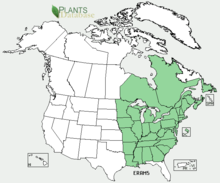Yellow trout lily: Difference between revisions
mNo edit summary |
mNo edit summary |
||
| Line 4: | Line 4: | ||
== Overview == | == Overview == | ||
The yellow trout lily (''Erythronium americanum'') is a common [[spring ephemeral | The yellow trout lily (''Erythronium americanum'') is a common [[Spring ephemerals|spring ephemeral]] wildflower that is part of the [[Liliaceae]] family and is native to the northeastern United States and eastern Canada. It is a [[perennial]] that grows in colonies and blooms between March and May. Each plant produces one nodding bright yellow flower with backwards bending petals and has dark green leaves that are mottled with a purplish-brown coloration. The leaves are where the flower gets its name from: the mottled coloration is said to be similar to the markings on trout. Other names for the yellow trout lily include the American trout lily, eastern trout lily, yellow dogtooth violet, and adder's tongue. <ref name="Texas">University of Texas. (19 March 2019). ''Erythronium americanum''. https://www.wildflower.org/plants/result.php?id_plant=eram5 </ref><ref name="adk">Wild Adirondacks. Wildflowers of the Adirondacks: Trout Lily (''Erythronium americanum''). https://wildadirondacks.org/adirondack-wildflowers-trout-lily-erythronium-americanum.html</ref> | ||
== Growth and Reproduction == | == Growth and Reproduction == | ||
Revision as of 08:45, 10 May 2022
Overview
The yellow trout lily (Erythronium americanum) is a common spring ephemeral wildflower that is part of the Liliaceae family and is native to the northeastern United States and eastern Canada. It is a perennial that grows in colonies and blooms between March and May. Each plant produces one nodding bright yellow flower with backwards bending petals and has dark green leaves that are mottled with a purplish-brown coloration. The leaves are where the flower gets its name from: the mottled coloration is said to be similar to the markings on trout. Other names for the yellow trout lily include the American trout lily, eastern trout lily, yellow dogtooth violet, and adder's tongue. [1][2]
Growth and Reproduction
The natural habitat of yellow trout lilies is deciduous woodland, and they grow best in moist, acidic soil with part sun or dappled sunlight. The plants tend to grow in clumps, forming dense clusters of leaves and flowers, and typically reach 3 to 6 inches in height.[1] The roots grow in the fall, and the flower sprouts, blooms, produces fruit, and dies before canopy trees fully leaf out in the spring.[2][3] Two versions of the yellow trout lily exist: sterile plants that do not produce flowers and reproduce via runners, and the flowering plants that reproduce sexually via seeds.[4][5] Each flower contains 4-7 seeds that are typically released in June and July and dispersed by ants, about 40% of which will successfully germinate.[5][6] Interestingly, although yellow is the most common color for pollen in flowering plants, the pollen and anther color of yellow trout lilies can be either red or yellow. This variation has allowed researchers to track pollen distribution from these plants. One 2018 study found that specific pollinators may have preferences for one pollen color over the other.[7]
Ecological Significance
The yellow trout lily is an important pollen and food source for many types of insects such as bees, butterflies, flies, and ants. Black bears reportedly eat the corms and white-tailed deer eat the seed capsules, although only to a limited extent. The plant's bulbs are a staple food source for Eastern chipmunks.[2][8] It also plays a role in soil nutrient cycling and retention, and about 75% of the roots are infected by arbuscular mycorrhizae, which is unusual for a spring ephemeral.[3][8]
References
- ↑ 1.0 1.1 University of Texas. (19 March 2019). Erythronium americanum. https://www.wildflower.org/plants/result.php?id_plant=eram5
- ↑ 2.0 2.1 2.2 Wild Adirondacks. Wildflowers of the Adirondacks: Trout Lily (Erythronium americanum). https://wildadirondacks.org/adirondack-wildflowers-trout-lily-erythronium-americanum.html
- ↑ 3.0 3.1 Lapointe, L., & Molard, J. (1997). Costs and benefits of mycorrhizal infection in a spring ephemeral, Erythronium americanum. The New Phytologist, 135(3), 491-500.
- ↑ Holland, P. G. (1980). Transplant experiments with trout lily at Mont St Hilaire, Quebec. Journal of Biogeography, 261-267.
- ↑ 5.0 5.1 Tessier, J. T. (2012). Methods of belowground movement in Erythronium americanum. Northeastern Naturalist, 19(sp6), 77-88.
- ↑ Muller, R. N. (1978). The phenology, growth and ecosystem dynamics of Erythronium americanum in the northern hardwood forest. Ecological Monographs, 48(1), 1-20.
- ↑ Austen, E. J., Lin, S. Y., & Forrest, J. R. (2018). On the ecological significance of pollen color: a case study in American trout lily (Erythronium americanum). Ecology, 99(4), 926-937.
- ↑ 8.0 8.1 Tessier, J. T. (2022). Severe frost but not shade could limit the future growing season of Erythronium americanum. Botany, 100(3), 275-282.


